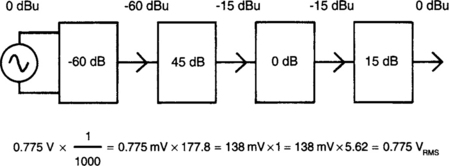The decibel
The decibel, or dB, is a logarithmic unit for expressing ratios, much beloved of engineers. Its popularity is due to the fact that it enables a wide range of numbers to be expressed conveniently.
Where we are talking about a ratio of two voltages then:
which means that ‘A is twice B’ is often expressed as ‘A is 6dB greater than B', and ‘A is ten times B’ becomes ‘A is 20dB up on B'. Gain or attenuation of circuit blocks are very well expressed like this (a negative gain is an attenuation, or a ratio of less than one). The ratio is ‘output/input’.
dB’s are also used to express signal levels a lot. Here some reference level should be stated to make the situation clear. The most common are:
though you may very well come across others. Where there is doubt it is often wise to try to find out what reference was used, as it can be a source of confusion.
The beauty of this system is that the level of a signal at various point in a chain can be found just by adding the dB values together. See Figure A.3. It is apparent that the calculation in dB’s is trivial compared to that using VRMS and gain/attenuation as ratios.
dB’s are also used sometimes to express relative power. The equation then used is:
This is because power varies proportionally to the square of voltage, as implied by Eqs 2.4d and 2.4e.
Figure A3 Illustration of signal level calculations using dB’s


